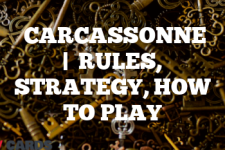Connect Four: Vertical Strategy Rules, Instructions, and Winning
1. Introduction
Connect Four is a popular two-player connection game in which the players first choose a color and then take turns dropping colored discs into a seven-column, six-row vertically suspended grid. The pieces fall straight down, occupying the lowest available space within the column. The objective of the game is to Connect Four of one’s own discs of the same color next to each other vertically, horizontally, or diagonally before your opponent.

2. Rules for playing Connect Four
- Connect Four is played by two players, who alternate turns.
- Each player chooses a set of colored discs (usually red or yellow) and holds them in reserve.
- Players take turns dropping one disc at a time into any of the seven slots in the top of the grid.
- The disc can fall to the bottom or land on top of any other disc already in the grid.
- The game continues until one player gets four discs of their color in a row. The four in a row can be horizontal, vertical, or diagonal.
- If the grid is filled completely and no player has four in a row, the game is a draw.
These are the official rules of Connect Four. However, some people play with ‘house rules’, such as allowing five in a row or using a larger grid.
3. How to Win at Connect Four
Winning at Connect Four requires a balance of defense and offense. Here are some strategies to help you win:
- Beginner Strategy: Try to build a ‘7’ shape with your discs. This gives you multiple ways to create a line of four, either diagonally or horizontally.
- Intermediate Strategy: Try to create multiple lines of three discs. This forces your opponent to block you, giving you the opportunity to complete a line of four on your next turn.
- Advanced Strategy: Try to control the center of the grid. This gives you more opportunities to build lines of four in multiple directions.
4. Best Strategies for playing Connect Four game
The best strategy for playing Connect Four involves thinking ahead and trying to anticipate your opponent’s moves. Here are some tips:
- Always keep an eye on your opponent’s discs and try to block them from getting four in a row.
- Try to create a situation where you have two potential lines of four, forcing your opponent to block one and allowing you to complete the other.
- Don’t just react to your opponent’s moves, but plan your own strategy and force them to react to you.
5. Scenarios for Connect Four
There are many possible scenarios in a game of Connect Four, and understanding these can help you improve your game. Here are some common scenarios and how to handle them:
- Defensive Scenario: Your opponent has three in a row and is about to make a fourth. In this case, you must block them or you will lose the game.
- Offensive Scenario: You have three in a row and an open spot for a fourth. In this case, you should go for the win unless your opponent is also about to win.
- Stalemate Scenario: The grid is almost full and neither player has a clear advantage. In this case, you should try to create a situation where you can win in two moves, forcing your opponent to play defensively.
6. Frequently Asked Questions about playing Connect Four game
Q: Can a game of Connect Four end in a draw? A: Yes, if the grid is filled and no player has four in a row, the game is a draw.
Q: Can I play Connect Four with more than two players? A: The official game is designed for two players, but you can create your own rules for more players.
Q: What is the best strategy for Connect Four? A: The best strategy is to balance offense and defense, try to control the center of the grid, and anticipate your opponent’s moves.
Additional Subtopics
History of Connect Four
Connect Four was first sold by Milton Bradley (now part of Hasbro) in February 1974.
Variations of Connect Four
There are many variations of Connect Four, including different grid sizes, three-dimensional versions, and versions with additional types of pieces.
Connect Four in Popular Culture
Connect Four has been featured in many TV shows and movies, including “The Simpsons” and “The Big Bang Theory”.
External Links
For more information, visit the official Connect Four website here.

Eve Brownlee was a gamer before gaming communities on the internet were a thing. Eve grew up playing traditional, standard deck card games like Rummy and Bezique, taking an interest in the classics Backgammon and Chess. Parlor card games like Bridge continue to keep Eve active in the community. After a long career, primarily in horticulture for USDA in Maryland, Eve now travels and writes on The Pineapple (pineapples.info) and contributes to Quora/Pinterest topics. Contact Eve via email.



